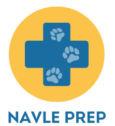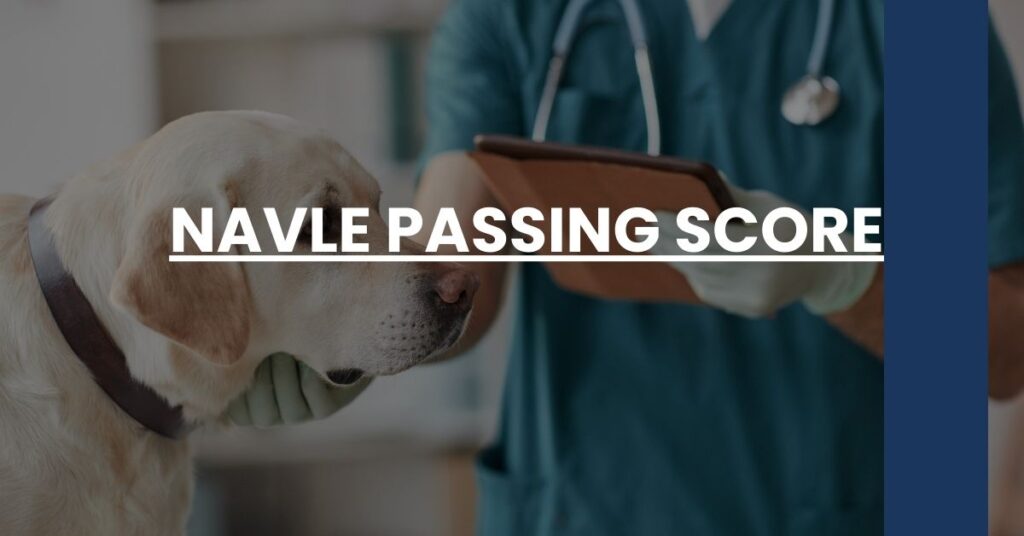The NAVLE passing score is set at 425 on a testing scale that ranges from 200 to 800. For eager veterinary graduates looking to clinch their profession’s licensure, achieving this score is a critical milestone to practice in the USA or Canada.
Here’s what you’ll gain from this article:
- Insight into what a passing score entails and its implications.
- The factors that may affect this all-important threshold.
- Tips to prepare and strategies to ensure you meet or surpass the passing score.
Reading on, you’ll be better equipped to navigate your path to veterinary success.
- Understanding the NAVLE
- What Constitutes the NAVLE Passing Score?
- The Grading Scale and Scoring Process
- Preparing for the NAVLE
- Retaking the NAVLE: What Happens If You Don’t Pass
- Recent Trends and Changes in NAVLE Scores
- NAVLE Scores and Veterinary Career Opportunities
- FAQs on NAVLE Scores
- Conclusion: Navigating the Path to Veterinary Success
Understanding the NAVLE
As you embark on the path to becoming a licensed veterinarian, you’ll encounter a significant milestone: the North American Veterinary Licensing Examination (NAVLE). Much like the bar exam for lawyers or the boards for human physicians, the NAVLE serves as the gateway to practicing veterinary medicine in the United States and Canada. Administered by the International Council for Veterinary Assessment (ICVA), it’s a comprehensive test that assesses your knowledge and skills in veterinary science.
To sit for the NAVLE, it’s essential you’re nearing the end of your accredited veterinary education or you’ve graduated recently. The exam covers a wide array of topics, from basic animal anatomy to complex clinical procedures, ensuring that only those with a well-rounded understanding of veterinary medicine are cleared for licensure.
What’s on the NAVLE?
The NAVLE consists of 360 multiple-choice questions, but only 300 of these count toward your score. Spread over a 7.5-hour period, it’s a test of endurance as much as it is of expertise. To succeed, you will need to demonstrate proficiency in:
- Pre-clinical sciences: pathology, pharmacology, and microbiology.
- Clinical sciences: medicine, surgery, and diagnostics.
- Animal species: predominantly small and large animals, with questions also extending to exotics and public health scenarios.
Understanding the structure and content of the NAVLE is your first step towards achieving your goal of becoming a fully licensed veterinarian. The real question, however, is what score will allow you to forge ahead on this career path.
What Constitutes the NAVLE Passing Score?
The NAVLE’s minimum passing standard is critical for your professional journey – this is the cart you must hitch to your hard work to drive towards success. To pass the NAVLE, you’ll need a score of 425 or more on a scale that spans from 200 to 800. This pass mark isn’t simply an arbitrary number; it represents a benchmark of competency agreed upon by experts in the field. It assures regulators and employers alike that you have the knowledge base and cognitive skills required to practice veterinary medicine safely and effectively.
How Is It Established?
The NAVLE passing score is set using a method called the modified Angoff approach, guided by panels composed of veterinarians across North America. This sort of criterion-referenced standard means the score reflects the judgment of professionals regarding the difficulty of each individual question and what constitutes a minimally competent practitioner.
It’s also noteworthy that the passing score remains consistent over time. It doesn’t matter whether you take the NAVLE during the spring or fall session; the passing score is always the same, ensuring fairness irrespective of when you take the exam.
Knowing that you need a 425 to pass, placing this objective into your study plans can sharpen your focus and drive you toward the appropriate depth of preparation needed to clear this hurdle confidently.
The Grading Scale and Scoring Process
Understanding how your efforts will be evaluated helps clarify your objectives as you study. The NAVLE is scored on a scaled system, which means your raw score (how many questions you answered correctly) is converted to a scaled score that factors in the relative difficulty of the exam. This scale ensures that performance standards remain consistent across different versions of the test.
Behind the Scenes of Scoring
Each question on the NAVLE plays a role in evaluating your competence, but not every question weighs equally on your final score. Here’s a breakdown of the scoring process:
- Raw scores: First, the total number of questions you answered correctly is tallied. This raw score is your baseline.
- Scaled scores: This raw score is then adjusted to account for the difficulty level of the test form. This is where the scaled score comes into play—a score designed to be comparable across different exam forms.
- Reported scores: Finally, your scaled score is reported to you and the licensing authorities. This is the score that determines whether you’ve met the passing standard.
The scoring process is intricate because it needs to be utterly fair. As you prepare for the exam, remember that understanding the scoring process can help you manage your exam strategies and focus your study priorities.
Preparing for the NAVLE
Studying for the NAVLE is a marathon, not a sprint. Reaching or surpassing the navle passing score requires a structured attack. Here are some proven strategies to set you on the right track:
- Make a study plan: Identify the topics you need to cover and allocate time to each area based on your personal strengths and weaknesses.
- Practice, practice, practice: Solve as many practice questions as you can. This will familiarize you with the exam format and help you identify areas where you need more study.
- Self-assessment: Take advantage of the self-assessment provided by ICVA. It mirrors the NAVLE’s structure and content, offering a crucial preview of what to expect.
Focus on mastering the subjects that will form the bulk of your exam – those related to common species such as dogs, cats, horses, and cattle. Remember, while the harder and more esoteric questions can certainly impact your score, it’s the core material that will carry you through.
Above all, your NAVLE prep should be a blend of theoretical knowledge and practical problem-solving. The key is to understand not just the “what,” but the “why” and the “how” behind veterinary procedures and best practices. This deeper level of understanding is what will help you think critically during the exam and, ultimately, in the practice of veterinary medicine.
As you approach your NAVLE prep, remember to view it as more than a hoop to jump through. It’s an opportunity to solidify your knowledge and gain confidence in your ability to step into your professional role. So, sharpen your focus, optimize your review strategy, and remember that each practice question answered, each hour of study logged, brings you one step closer to achieving a score that marks not just competence, but excellence.
Retaking the NAVLE: What Happens If You Don’t Pass
The moment you get your NAVLE results can be nerve-wracking, especially if you find yourself falling short of the navle passing score. However, it’s crucial to remember that this isn’t the end of the road. If you don’t pass the NAVLE on the first try, you can retake it. Here’s what you should know:
- Attempt limitations: There is a cap on how many times you can sit for the NAVLE. Currently, a candidate is allowed five attempts within a five-year period after graduating from a veterinary college.
- Waiting periods: If you need to retake the exam, you must wait until the next testing window which typically occurs in the spring and fall.
- Preparation changes: Use your score report to guide your studies. Focus on the areas where you fell short and consider changing your study strategies or seeking additional resources.
To dive deeper into retaking the NAVLE and to understand what your score report means for your future preparation, please visit ICVA’s FAQs. Remember, failure is a natural step on the path to success. Each attempt is a learning experience that refines your understanding and brings you closer to achieving your goal.
Recent Trends and Changes in NAVLE Scores
Being aware of current trends in navle passing scores and pass rates can provide valuable context for your test preparation. While individual scores remain confidential, aggregated data showing overall trends can offer insight. For a detailed look at the latest NAVLE scores and trends, refer to the NAVLE Public Technical Report.
Recent years have shown slight fluctuations in pass rates, which could reflect changes in the test form or shifts in the preparation levels of test-takers. Schools may also adapt their curricula to address areas where students commonly struggle, potentially impacting future pass rates. It’s essential to keep in mind that while trends can be informative, your individual outcome is most influenced by your preparation and mastery of the material.
NAVLE Scores and Veterinary Career Opportunities
Your navle passing score is more than just a license to practice; it can be a stepping stone to various opportunities within the veterinary field. While passing the NAVLE is the primary goal, exceptional scores may be advantageous for competitive fields such as specialty internships or residency programs.
In the veterinary world, where professionalism and competence are of the utmost importance, a solid performance on the NAVLE can enhance your portfolio as a knowledgeable and reliable practitioner. To find out how your NAVLE results can impact your career trajectory, St. George’s University’s guide offers a wealth of useful information: What to Know About NAVLE Results.
FAQs on NAVLE Scores
When preparing for the NAVLE, having questions is normal. Here are a few common inquiries that you might have on your mind:
- How long will it take to receive my score? Scores are typically released within a month after the exam window closes.
- Are NAVLE scores confidential? Yes, they are shared only with you, the licensing boards, and, if you permit, your veterinary college.
- Can a self-assessment predict my performance on the actual NAVLE? While self-assessments are beneficial practice, they should not be relied upon as exact predictors of your NAVLE performance, but rather as tools for identifying areas needing improvement.
For more FAQs and detailed explanations regarding the NAVLE scores, visit ICVA’s FAQs. These resources are there to clear your doubts, helping you to focus on what truly matters – your exam preparation and future career as a veterinarian.
Conclusion: Navigating the Path to Veterinary Success
In the quest to attain the navle passing score, remember that each study session, every practice question, and all the dedication you pour into your preparation contributes to not just passing the NAVLE, but excelling at it. The passing score represents the bridge between your educational journey and the start of your dream career in veterinary medicine. As you prepare, know that this exam is a testament to your commitment to animal health and welfare.
As you navigate this path, keep in mind the powerful words of Louis Pasteur, “Let me tell you the secret that has led to my goal: my strength lies solely in my tenacity.” May your tenacity guide you through your NAVLE preparation and beyond, as you join the noble ranks of licensed veterinarians.
Remember, the path to veterinary success is marked by continuous learning and growth. Your NAVLE score is just the beginning. With every step forward, you’re not only proving your competence but also forging a legacy of care and expertise that will define your professional life. Good luck, and here’s to a bright future in veterinary medicine!
NAVLE passing score guide: Uncover what you need to succeed on the veterinary licensing exam and kickstart your career.

